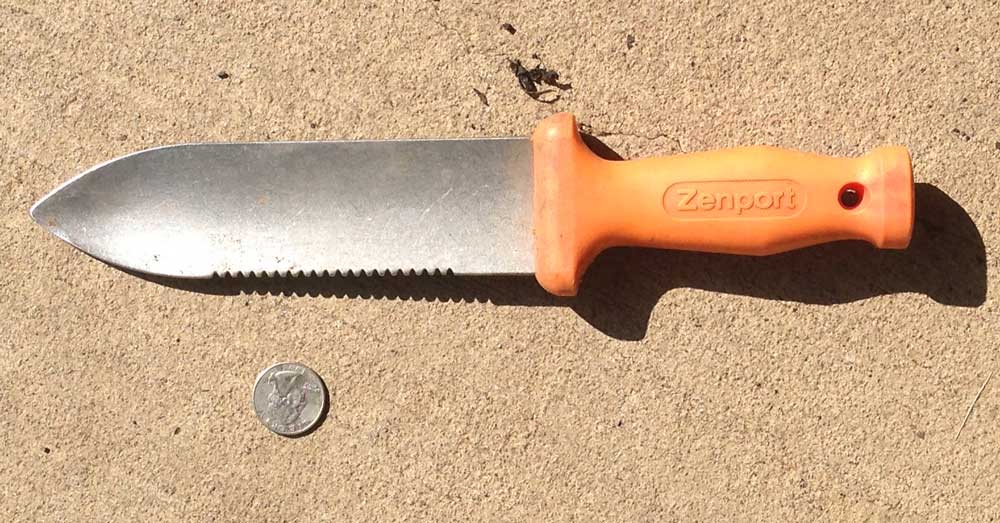When I was choosing what gifts to give friends this winter, there was one item that I knew would be at the top of the list: a hori hori knife. Why? Because the sturdy Japanese blade of a hori hori can redefine your gardening experience. With its saw-tooth edge and pointed, slightly concave blade, the hori hori, also known as Japanese gardening knife or soil knife, is adept at a range of activities, from precise weeding to effortless planting. Some of my friends say it never leaves their hands (or leather sheath on their belt) when they are in the garden.
This article will guide you through this handy tools features and practical uses, and suggest what to look for when choosing the perfect hori hori to suit your gardening style.
Key Takeaways
- The hori hori knife is a versatile gardening tool with a serrated edge on one side for cutting through roots, a sharp or smooth edge on the other for precise planting and trimming, and a pointed tip.
- Depending on the metal used in the blade and subtleties in design, the hori hori knife can offer great durability, rust resistance, and comfortable use, and provides an excellent alternative to a trowel.
- Beyond gardening, the hori hori knife is celebrated for its practicality in a variety of tasks, like trimming and neatening the edges of garden beds and pathways, breaking up compacted soil, and even crafting.
The Ultimate Tool for Gardeners: Hori Hori Knife Explained

Imagine a tool so versatile that it feels like a natural extension of your own hand. The hori hori knife, with its ingenious blend of a serrated edge on one side and sharpened edge on the other, is precisely that—a gardener’s Swiss Army knife. ‘Hori hori‘ is derived from the Japanese word for “to dig” and combines the benefits of a sharp edge, a serrated edge, a concave blade for troweling, and construction sturdy enough to hoe and dig out weeds. While there are specialized tools that optimally perform their respective garden tasks, you would be hard-pressed to find a more versatile implement.
Legend says that 16th-century emperor Toyotomi Hideyoshi’s mandate for the confiscation of swords pushed Japanese blacksmiths to turn to producing other implements, which resulted in a dramatic improvement in gardening tools.
Serrated Edge Perfection
The serrated edge of a hori hori knife ripping through stubborn roots and tenacious weeds is indeed satisfying. It’s akin to having a miniature saw at your disposal, capable of handling the unexpected challenges that arise in the untamed wilderness of your garden. Serrations allow the blade to cut through dense perennial roots or liberate a root-bound plant with precision.
Smooth Blade Efficiency
The straight, sharp edge of the hori hori has as many uses as any knife, whether it is trimming leaves or twine, cutting fabric, or opening bags. It’s perfect for:
- making clean, straight cuts
- planting bulbs
- slicing open bags of soil
- trimming plants with accuracy
It’s the kind of efficiency that makes gardeners wonder how they ever managed without it.
Heavy Duty Construction
Any great tool is built upon durability, and a good hori hori features a high-quality blade, either high-carbon or stainless steel (the most common preference), and a full tang that extends through the length of the handle and helps withstand the demands of prying and levering that come with everyday use.
Look for a good ash, walnut or other hardwood handle featuring heavy duty rivets, or a very sturdy synthetic handle designed for a grip that is both secure and comfortable, allowing you to use the hori hori for whatever task is at hand without worrying about damaging it. Some gardeners prefer a bright plastic handle that enables them to easily locate their knife, and others prefer the more traditional and organic feel of a wood or composite handle. In recent years garolite, also known as G10, has become a more popular choice for handles among those who prefer synthetic.
A Cut Above: Varied Designs of Hori Hori Knives
Today the choices of style of hori hori knives isn’t quite limitless, but the growing popularity of the tool has lead to many different options and lots of “improvement” on the original concept. You can buy hori horis with blades that are more knives than trowels, with highly ergonomic handles, and with flat or notched rather than pointed tips, but the essential artistry of the design and its utility remain. You can also buy a variety of accessories for them: a leather sheath or synthetic sleeve, wrist straps, sharpening and polishing tools, and even specialized gloves.
Stainless Steel or High Carbon Steel?
Stainless steel is probably the default choice for many gardeners when it comes to hori hori blades because it is resistant to rust and corrosion, holds an edge reasonably well, and is easy to clean. On the other hand it is not as easy to sharpen as carbon steel and doesn’t usually hold an edge as well.
A high carbon blade, on the other hand, can get an incredibly sharp edge, holds an edge longer than stainless steel, is easier to sharpen, and can be tougher and more durable than stainless. However it requires a bit more maintenance and can be more expensive.
Handle Design: Traditional or Ergonomic?
At least half of the effectiveness of any garden tool is determined by its handle, and the hori hori knife is no exception. But considering that you might find yourself using this tool more than any other, we have to say it comes down to personal choice. The handle need to feel solid, balanced, but most importantliy comfortable in your hand for long periods of time while you may be bent over or reaching for a distant branch or leaf.
Using a Good Sheath
One of the great conveniences of the hori hori is that it is easy to wear in a sheath attached to your belt, where it is easy to access but also protected (and also protects you). There are some beautiful leather sheaths on the market, but again there are some gardeners who prefers synthetic sheaths that are easier to clean and maintain. I prefer a leather sheath because I like the feel. In any case we consider the sheath an essential companion to the knife, providing a snug home that shields the blade from the elements and the gardener from its sharpness.
Practical Applications: Putting Your Hori Hori to Work

Here are some other common uses for a hori hori knife.
Weeding with ease: Even the calmest gardeners find their patience tested when grappling with weeds. The hori hori knife is a champion in this arena, its blade shape engineered to cut roots and lift weeds effortlessly. It may not turn weeding from a chore into a pleasure, but considering the importance of weeding in most early-stage ecological gardens, it can be a big contributor to your happy factor.
Planting made simple: Its pointed tip dives into the earth with precision, making it an ideal substitute for a trowel or even a hand rake, and perfect for digging. Many hori horis now come with measurement markings on their blades to ensure that seeds and bulbs are nestled at just the right depth, and that holes are dug with more precision.
Digging and loosening soil: The sharp, semi-serrated blade of a hori hori knife is excellent for breaking up compacted soil, digging holes for planting, and removing roots or stubborn weeds.
Cutting through roots and sod: The strong, sturdy blade can slice through tough roots and cut through sod or turf when prepping new garden beds or landscaping areas.
Transplanting plants: The knife can be used in digging up and separating plants for transplanting or dividing perennials.
Harvesting vegetables and fruits: The serrated and cutting edges are useful for cutting through stems and stalks when harvesting crops from the garden.
Cleaning and maintaining garden beds: The knife can be used to trim and neaten the edges of garden beds and pathways.
Outdoor camping and survival: A hori hori knife can be a handy tool for outdoor enthusiasts, as it can be used for digging, cutting cordage, preparing kindling, and other tasks.
Landscaping and hardscaping: Professionals in landscaping and hardscaping may use hori hori knives for digging, edging, trenching, and other tasks involved in creating and maintaining outdoor spaces.
Crafting and woodworking: The sturdy blade can be used for basic whittling, carving, and other crafting projects involving wood, bark, or other natural materials.
Multipurpose Mastery
Beyond the garden, the hori hori knife’s versatility shines in settings as varied as camping trips and seed collecting adventures. Its robust structure and multifunctionality have earned it a reputation for being a reliable companion in the great outdoors, whether you use it only to cut roots or you’re cutting kindling or opening a well-deserved beverage after a day of exploration.
Care and Maintenance: Keeping Your Hori Hori Sharp and Effective
As with any valued tool, maintaining and caring for a hori hori knife ensures its continued effectiveness. Here are some tips for keeping your knife in top shape:
- Regularly sharpen the blade to keep it sharp and ready for action.
- Clean the blade after each use to remove any dirt or debris.
- Periodically oil natural wood handles to preserve their beauty and functionality.
Hori Horis and the Garden Experience
For many gardeners tools are not just necessities, but aids to experiencing the many gifts the garden offers. The hori hori’s ability to handle a diverse range of tasks with grace and durability makes it more than just a knife; it often becomes a gardener’s trusted companion.
Frequently Asked Questions
How often should I sharpen my hori hori knife?
Entirely up to you. We know many gardeners who’ve gotten years and years of use out of their hori horis without touching the blade or handle. We know others who touch up the edge and point with a sharpening stone or diamond rod weekly. A lot depends on the type and intensity of use.
Can the hori hori knife be used for tasks other than gardening?
Absolutely. The hori hori knife can be used for many tasks other than gardening, such as camping and bushcrafting, due to its durable build and multipurpose functionality.
Is the hori hori knife suitable for heavy-duty tasks like cutting through roots and tough soil?
Yes, the Hori Hori knife is suitable for heavy-duty tasks like cutting through roots and tough soil due to its heavy-duty construction and serrated edge.
How do I clean my hori hori knife after use?
The methods that are appropriate for cleaning your knife depend on its handle and blade materials, and we suggest first referring to the manufacturer’s instructions. Synthetic handles can be cleaned with a mild soap solution and a soft brush, while natural wood handles might benefit from occasional wash and oiling, as will some high-carbon blades. In all cases you should thoroughly dry your hori hori before returning it to a sheath.
What is the best way to store my hori hori knife?
The best way to store your hori hori knife is indoors after cleaning and drying, preferably in its leather sheath, to protect it from environmental damage and to maintain its sharpness and longevity.
